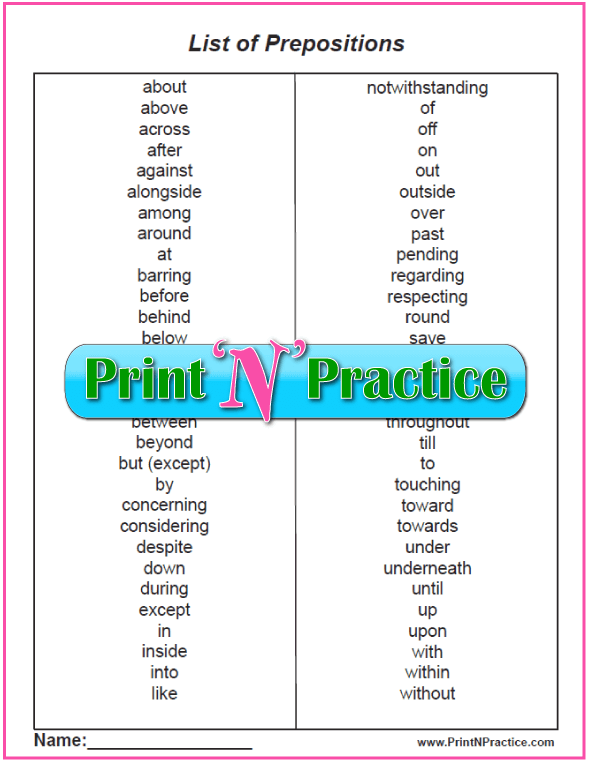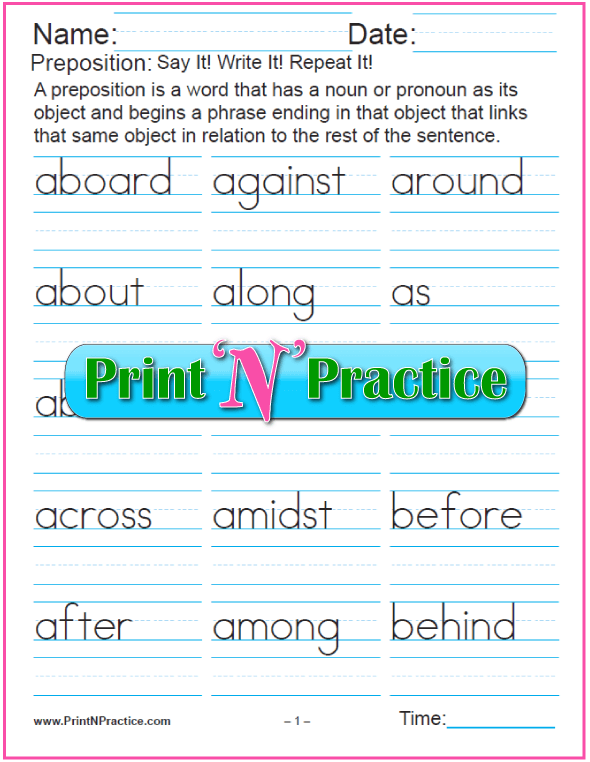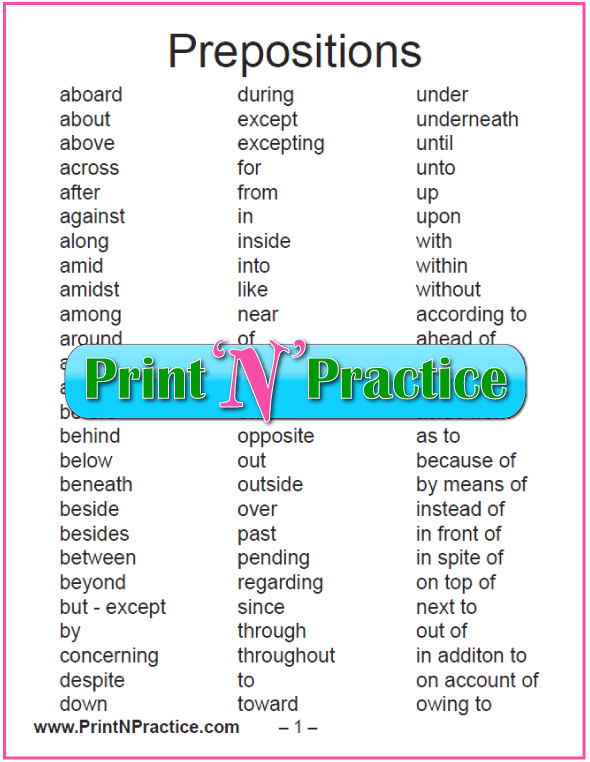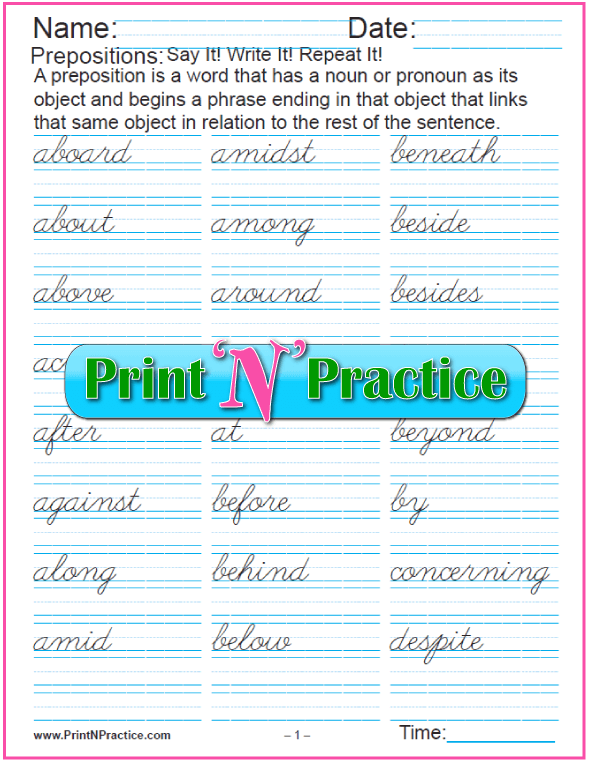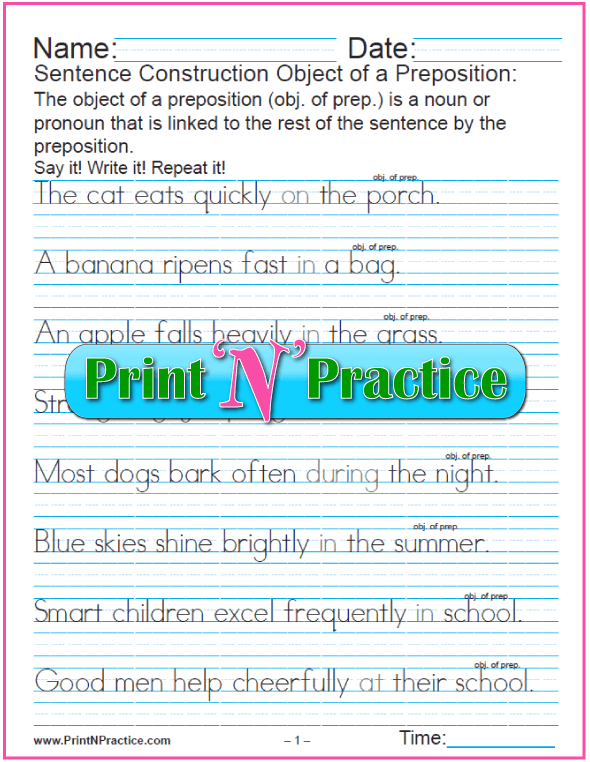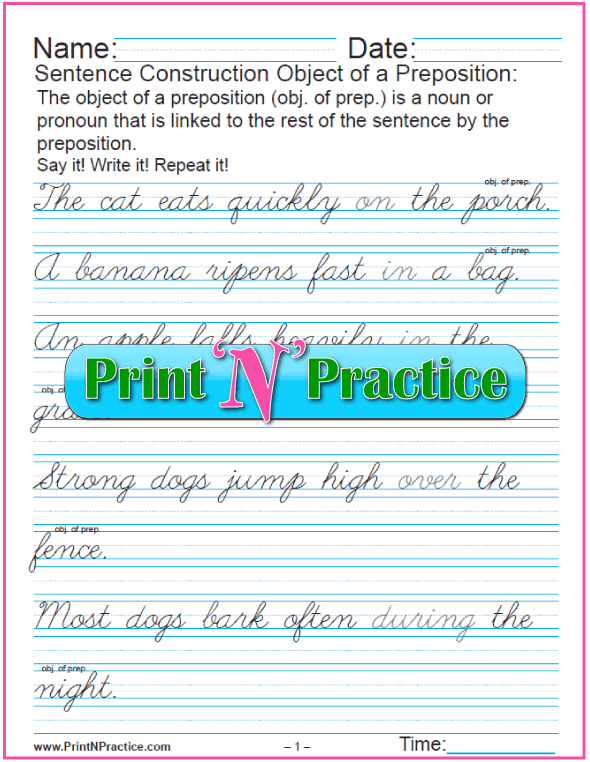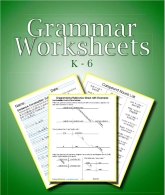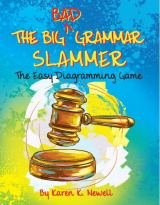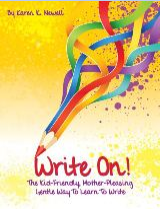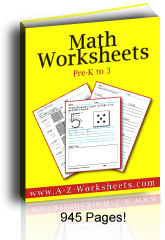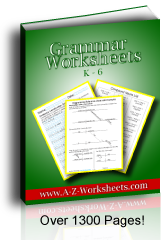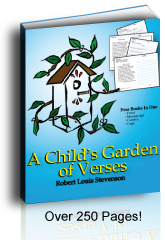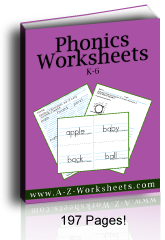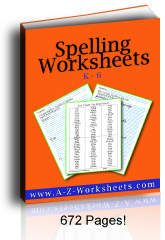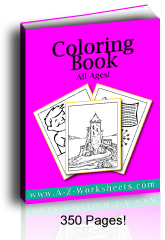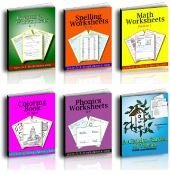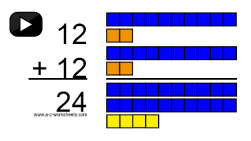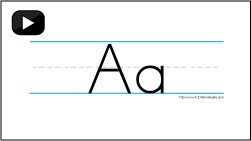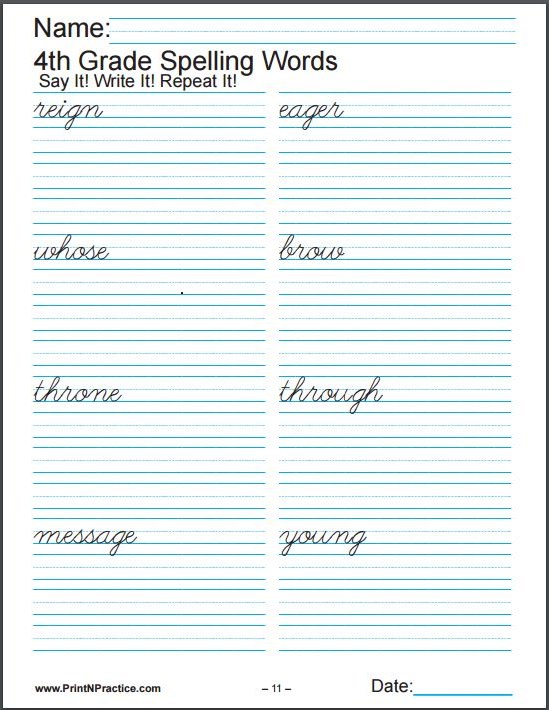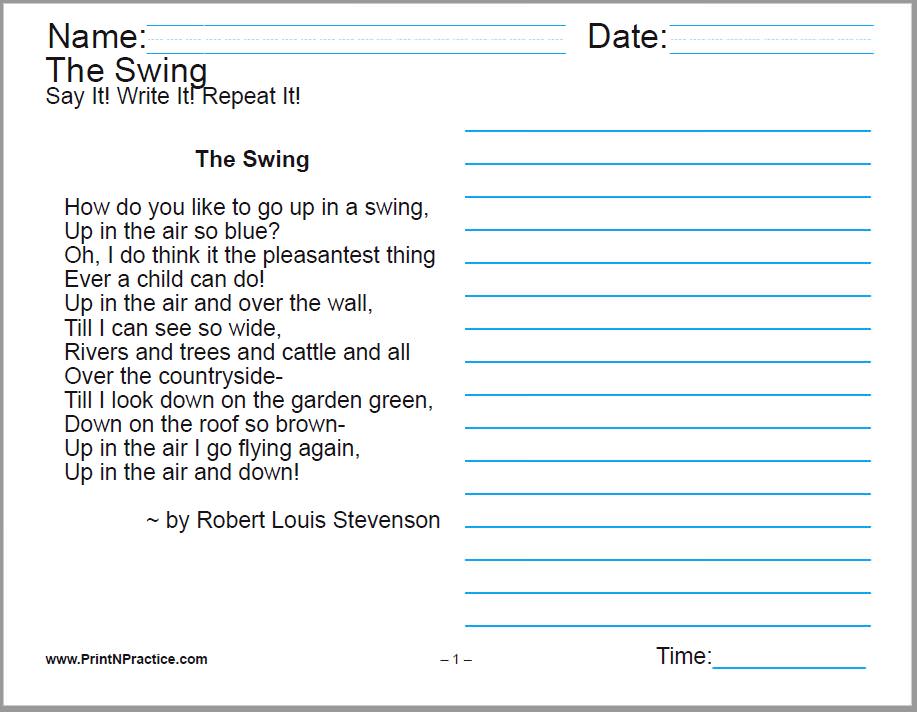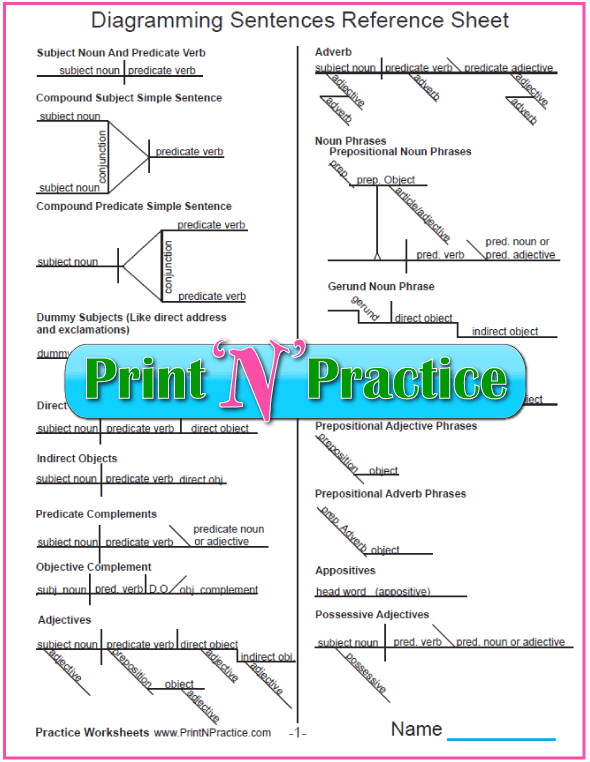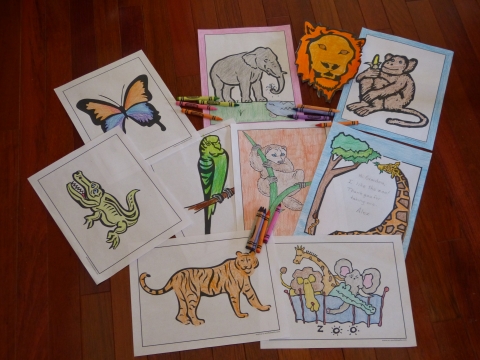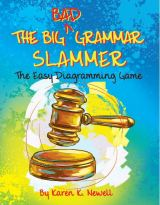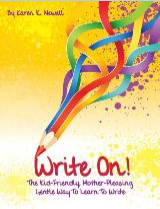English List of Prepositions
1. Use a List of Prepositions
If your students memorize the list of prepositions, they will be able to recognize prepositional phrases much more easily. If they separate these phrases from long sentences, they can better understand what they're reading, writing, or editing.
This page has several sets of preposition worksheets and charts below.
Outside memorizing the list, referring to a preposition list on a chart is next best. Keep it handy for diagramming sentences.
Hint 1: Think of the meaning of pre- (before) position. The preposition comes before its object, either a noun or a pronoun
Hint 2: Many times the preposition is followed by an article: a, an, the; or an adjective.
- on a table...
- through an exit...
- in the box...
- with warm greetings...
Prepositions always point to an object noun which is why prepositions are not placed or left at the end of sentences, clauses, or phrases. A preposition needs its object unless the object is understood substantively as with prepositions of place.
When you find a preposition at the end of a sentence in your own writing, read it out loud to see if you can re-word the phrase.
Be encouraged to stay in touch! Join my free newsletter....
Join To Receive My Free PrintNPractice Newsletters!
Free Online Worksheets For School, Homework, And Homeschool Practice
Free Online Teacher Resources - Free Homeschool Curriculum
For teachers and parents: PrintNPractice free printable worksheets are all copyright-free, digital activities for students. Use them in homeschool, interactive notebooks for online classrooms, Google classroom, distance learning, tutoring and learning pods, and hybrid school.
- No prep.
- No tracking.
- Self learning.
- Copyright free.
- Lifetime license.
- Diverse learners.
- Easy drill-and-kill.
- Interactive worksheets.
- Printable morning work.
- Paperless morning work.
- Go printable or paperless.
- Stay on track. Summer review.
- Easy elementary school curriculum.
- Remote learning packets or homework.
- Most need no answer key or key is included.
- Videos for audio and visual learners. God bless headphones!
See free teacher and homeschool digital interactive school-at-home learning exercises with no login, no tracking, no sign-up, no voucher, no account, and no credit card. Loads of digital activities for device-based learning.
2. Printable Prepositions List & Worksheets
Learning a list of prepositions can make both reading and writing easier.
- An alphabetical preposition list can be used as a writing prompt to improve writing as well as a reference chart.
- A list of prepositions can also help students discover prepositional phrases when they are learning to diagram.
- Separating the prepositional phrases from the rest of a sentence can make it easier to name the other parts of speech and to understand the meaning of the sentence.
For example: Think of the long winded authors from the late 1800s.
- Some of their sentences are many lines long.
- Some of their paragraphs are a full page long.
- (Remember - These authors were paid by the word. Aha moment!)
If you rewrite the sentence with no prepositional phrases, it is easier to understand the author's message.
Printable List Of Prepositions
Kids can learn to recognize prepositions with this list of common prepositions. Memorizing the list can make grammar class easier. I like to print this list on card stock and keep it in a binder. There are two sides to this printable list and there are more preposition worksheets below:
3. Preposition Worksheets
List Of Prepositions To Copy
- The first set here has larger line spacing for younger students.
- The next includes a reference chart with the same list in manuscript, yet smaller spacing for older students.
- The last is written in cursive writing.
- If you print these two up, the lines are nearly college rule, excellent for middle school and high school. Enjoy!
Manuscript
Smaller Spacing
Cursive Writing
4. Preposition Definition
What are prepositions?
A preposition is a word that has a noun or pronoun as its object and begins a phrase ending in that object that links that same object in relation to the sentence.
Prepositions are very useful. They often link other nouns to the main ideas in the sentence. They also define position or place.
Prepositions help define instructional material. They help us see the steps we should take in making a recipe or piecing a bike. Without the prepositions we might not "position" the pieces correctly.
5. Object of a Preposition
Object Of A Preposition - The object of a preposition is a noun or pronoun that is linked to the rest of the sentence by the preposition.
- The pencil is under the desk.
- Desk is the object of the preposition, or the word under.
Any noun can be an object of a preposition.
Printable Object of a Preposition Worksheets
The prepositions in these sentences are printed in gray so that they are easy to see. Have your children practice writing these sentences to see the way we use the list of prepositions in the real world.
Manuscript Prepositions
Cursive Prepositions
6. Compound Prepositions?
I had not heard of compound prepositions until I'd seen them in one of our children's modern English books.
Personally, I think that the "compound" prepositions are sets of words (phrases?) that need to be edited. There are so many times when we could simply phrase our writing better.
For example:
- "on top of"
means "on the top of something", which makes it two prepositional phrases:
- "on the top",
- and "of something".
I'd keep an eye for this. Even though it is true that we often speak using what amounts to compound prepositions, writing gives us a chance to be more precise in our choice of words.
It is especially helpful when we're free to use an editor or word processor and read our work out loud to be able to see that we are "missing something" in our writing.
Often it is the preposition's object. :-)
The better we choose our words, the better others will understand our writing.
7. Prepositional Phrases Enhance Stories
Normally prepositional phrases can add depth of detail to a sentence. the descriptive use of prepositional phrases really enhances a story.
On the other hand the overuse of prepositions is as boring as a run-on sentence.
They can be used to create adjective phrases describing the subjects and objects, or as adverb phrases describing verbs.
Remember the authors from the 1800s? Since they were paid according to how long their texts were, they had an incentive to be more descriptive. Your children can add adjective phrases and adverb phrases to improve descriptive text and to increase text length easily.
How Did The Great Authors Use Prepositions?
In the days of Charles Dickens writers were paid by the word. More words, more money.
Guess what?
They stuffed their writing with prepositional phrases, both adjectival phrases and adverbial phrases. Now we know why they wrote such long descriptions!
My high school children were relieved to hear that this was the "great" authors' secret. They were also glad to hear that this is no longer the usual way to write. :-)
As a matter of fact, they were happy to learn that if a reading selection were too long or verbose, they could simply remove the prepositional phrases one at a time to make sense of the sentence. Then they could restore the phrases to understand the details.
How Do You Find Prepositions In A Sentence?
If children can recognize the preposition (hence the beauty of memorizing or nearly memorizing a list of prepositions), it's easy to find the prepositional phrases.
- Memorizing the list is the easiest way for some children to find the prepositions.
- Having a short list handy can be a helpful aid, too.
Prepositions precede articles and adjectives or the object noun of the preposition, so sometimes it is easier for children to see the articles, (a, an, the).
Another way is to work backward from the nouns (persons or things). Ask the questions, "Is there a person or thing?" "Are they linked or connected to something?" Try varying approaches to fit different learning styles.
Once you have found the phrase you can mentally separate it from the sentence to see the main sentence more easily. See how the eleven word sentence below is really a two word command.
- "Put it in the basket in the corner of the kitchen."
The prepositions "in", "in", and "of" explain where to put the basket. Remove the prepositional phrases to see that "Put it." is the simple thought in this sentence.
Objects of prepositions are different from direct objects and indirect objects even though they are all nouns or pronouns. See more definitions and practice worksheets at the links.
Thank you for visiting!
~Mary
* American English Grammar And Writing Worksheets
<< This download has my favorite grammar PDFs for practice in elementary and middle school grammar lessons.
If you like the samples on this page, you'll love the grammar download which includes diagramming charts and English Grammar Definitions ebook.
These are great for easy practice and for ESL students.
Get the set. And enjoy!
* Karen Newell's Grammar And Writing Worksheets
Fast way to teach basic grammar!
Simple step by step workbook.
* Elizabeth O'Brien's English Grammar Revolution
Elizabeth O'Brian has the best diagramming workbooks I've seen. Her website also has videos to go with each lesson.

Mary Fifer, BSBA is webmaster, author, and researcher at PrintNPractice.com. She has created elementary school practice exercises using printable or digital interactive worksheets. Perfect for today's teachers, tutors, homeschoolers, and students!
Thank you for visiting and for sharing. :-)
Be encouraged to stay in touch! Join my free newsletter....
